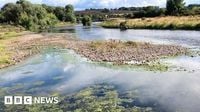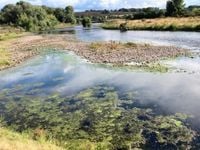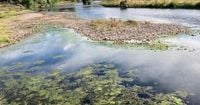South-east Wales has officially entered drought status, according to Natural Resources Wales (NRW), after experiencing the driest six-month period since the notorious drought of 1976. The declaration, made on August 14, 2025, comes as the region faces a relentless stretch of hot, dry weather and rainfall well below historical averages. The affected area encompasses all of Caerphilly County Borough, the Rhondda and Taff valleys, the Vale of Glamorgan, and stretches across to Monmouthshire, as confirmed by multiple sources including BBC News, Nation.Cymru, and the Caerphilly Observer.
The announcement was made following a meeting of the Welsh Government’s Drought Liaison Group, where NRW confirmed that the trigger thresholds for drought had been met. While the rest of Wales remains in a status of ‘prolonged dry weather,’ NRW teams are maintaining close surveillance of river flows, groundwater levels, and environmental impacts throughout the country.
“The weather we’ve seen this spring and summer has been exceptional, with Wales recording the driest six-month period since the drought of 1976,” said Rhian Thomas, Sustainable Water and Nature Manager at NRW, in statements reported by BBC News and Nation.Cymru. “The lack of significant rainfall has taken its toll on the environment, and we are receiving reports of low flows and dry riverbeds in some locations, and low groundwater levels – as well as reports of fish in distress and algal blooms.”
The statistics are stark. South-east Wales received only 53% of its average rainfall in July 2025. Between January and July, the region recorded just 555mm of rainfall, resulting in low river flows and depleted groundwater. This marks the driest six-month spell in nearly half a century and the 16th driest in the last 190 years, according to NRW data cited by Nation.Cymru and Caerphilly Observer. The conditions are reminiscent of 2022, when similarly dry weather led to the whole of Wales being placed into drought status by September.
The environmental impact has been immediate and visible. Rivers such as the Usk and Wye have been hit particularly hard, with persistently high water temperatures threatening fish populations. “Catchments in south-east Wales have been particularly impacted, with rivers receiving very little rainfall in recent months, and the Usk and Wye recording persistently high river temperatures which can threaten fish populations,” Thomas explained. Across the region, reports have surfaced of low flows, dry riverbeds, fish in distress, and algal blooms, painting a worrying picture for local ecosystems.
But it’s not just rivers and wildlife feeling the strain. The drought has also dried up private water supplies in some areas, forced farmers to seek alternative sources for livestock watering, and made supplementary feeding necessary due to reduced grass growth. The loss of recently planted trees has added to the woes for land managers and those involved in tree planting initiatives. Recreational activities, too, have been affected, with navigation and access on some waterways becoming more difficult as water levels drop.
Despite the challenging conditions, the public drinking water supply remains safe for now. Both NRW and Dŵr Cymru Welsh Water have reassured residents that reservoir levels are close to what would be expected at this time of year, with no immediate plans for temporary restrictions or hosepipe bans. However, people and businesses are being strongly urged to use water wisely this summer. “While many people are enjoying the summer holidays, we’re urging people to be mindful about their water use and consider how they can conserve water at home and in work,” Thomas said, echoing advice found on the Waterwise website.
NRW is stepping up its response in line with its Drought Plan. This includes increased monitoring of river flows and groundwater, closer cooperation with the Welsh Government, water companies, and other partners, and targeted actions to relieve environmental pressures. The agency is also encouraging the public to report any environmental concerns—such as fish in distress, dry riverbeds, or pollution—via its incident hotline or online form. “We also urge people who may be out and about enjoying the environment to report any emerging environmental concerns,” Thomas emphasized.
For farmers, the drought is more than just a temporary inconvenience. The combination of reduced grass growth and the need for supplementary feeding is putting additional financial and logistical strain on agricultural operations. The drying up of private water supplies has forced some to seek alternative sources to keep their livestock hydrated. These challenges are likely to persist, as Thomas warned that “after such an exceptionally dry start to the year, it is going to take considerable time for rivers, groundwaters and soils to recover—even if we start to see some rain in the forecast.”
While the drought declaration is rooted in environmental factors rather than reservoir levels, the broader context cannot be ignored. Scientists, including Sir David King, chair of the Global Climate Crisis Advisory Group and former chief scientific adviser to the UK government, have pointed to climate change as a key driver behind the increasing frequency and severity of such extreme weather events. “Drought conditions are a clear signal that climate collapse is unravelling our water, food and natural systems,” King told the BBC. Although directly linking individual droughts to climate change can be complex, the trend toward hotter, longer, and more frequent heatwaves is consistent with scientific predictions for a warming world.
The rest of Wales, while not yet in official drought status, is not immune to the ongoing dry spell. NRW continues to monitor conditions closely, ready to take further action if necessary. For now, the focus remains on south-east Wales, where the combination of low rainfall, high temperatures, and environmental stress has pushed the region into drought for the first time in years.
As the situation unfolds, NRW’s message is clear: use water wisely, stay alert to environmental impacts, and be prepared for a slow recovery even if the weather turns. The drought of 2025 is a sobering reminder of the vulnerability of natural systems—and the communities that depend on them—to the changing climate and the pressing need for collective action and resilience.






